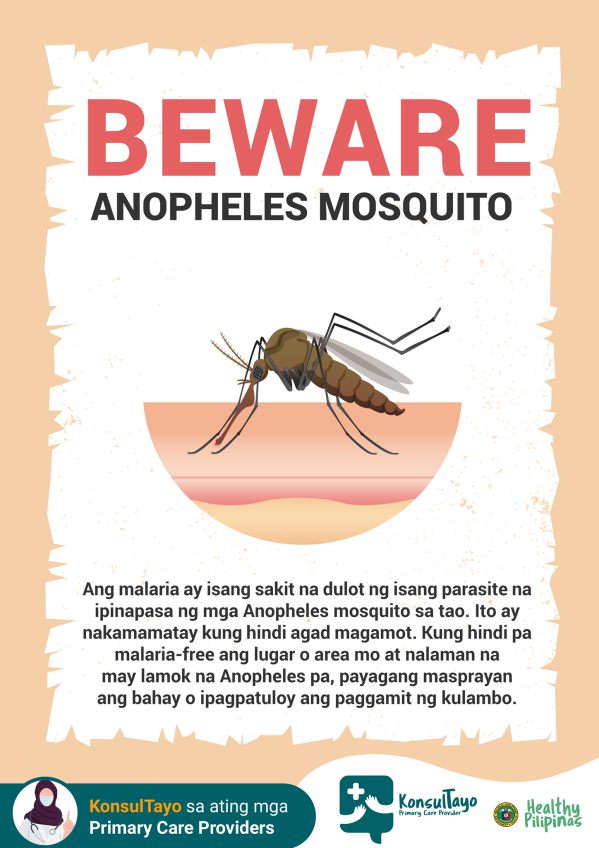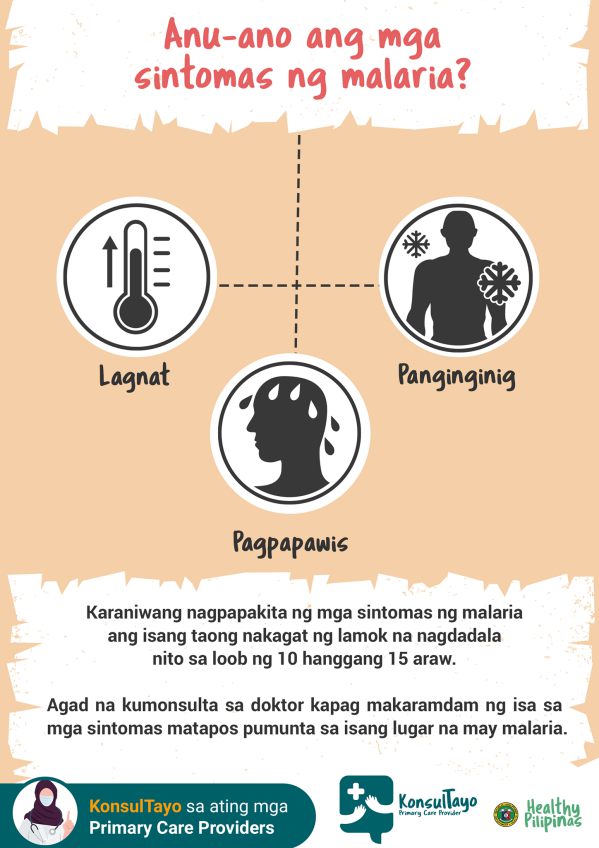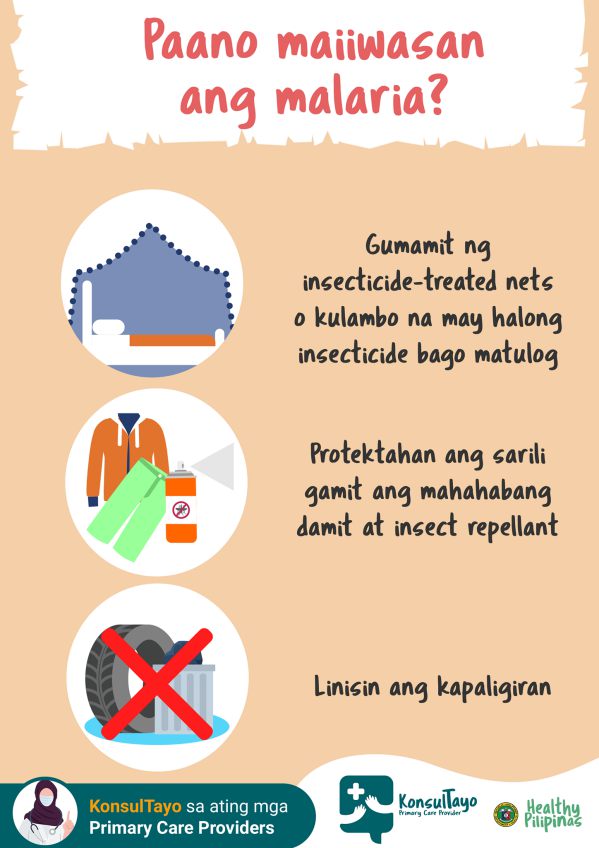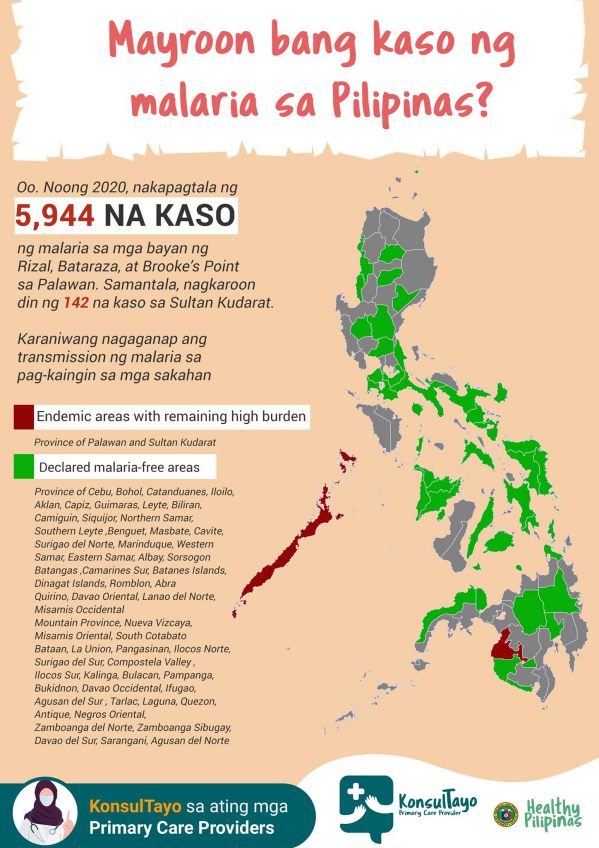What is Malaria
Malaria is a disease caused by one or more species of the protozoan parasite called Plasmodium which is usually transmitted through the infective bite of a female Anopheles mosquito, and rarely through blood transfusion or the sharing of contaminated needles and syringes. As a disease, it may result in death if not promptly detected and properly treated.Malaria was historically the most common and most persistent mosquito-borne infection in the Philippines (although it is now being overtaken by arbovirus infections like dengue).
Malariae is present in some areas, where it may contribute a minority of cases (generally less than 5%). Historically, cases of P ovale have been recorded in Palawan, Sulu and Luzon, but this species is rare in the Philippines. A fifth species, P knowlesi, is zoonotic among certain species of macaque monkey, notably in Sabah, Malaysia, but also in Palawan where it was first isolated in 2006. A survey undertaken by the Research Institute for Tropical Medicine (RITM) in 2010 showed that 9 of 16 presumed cases of P malariae from sentinel sites in southern Palawan tested positive for P knowlesi by Polymerase Chain Reaction (PCR) (2).
Malaria infection usually thrives in forested, hilly or mountainous, and hard to reach areas. Disease transmission is perennial and generally higher during the rainy season. It may occur during a single rainy season peak each year or in a biphasic peak, as in the south of the country, where two distinct rainy seasons occur. High-risk groups include upland subsistence farmers, forest workers, indigenous populations (IP) and settlers in frontier areas, and migrant agricultural workers.
The principal vector throughout much of the Philippines is Anopheles flavirostris – mainly a foothill, stream-breeding species (although not entirely restricted to that environment), and found from coastal plains near sea level up to 600m elevation – occasionally higher (up to 1,500m). It has a strong preference for clear, slow-moving fresh-water habitats that are typical-ly partly shaded by vegetation and with stream margins that contain aquatic plants. This species is both endo- and exophagic. It is opportunistic in its feeding habits and has a short flight range of just 1-2 km.
Other anopheline species are present but are much less prominent as actual or potential vectors: An balabacensis in upland forested areas, An maculatus and An mangyanus. An litoralis is found in the coastal areas of Tawi-Tawi and other parts of southern Philippines, and may have a role in maintaining transmission in fishing and coastal communities (1).
Malaria is both a health problem and a socio-economic concern that affects the overall well-being of people. It undermines the health and welfare of families, endangers children’s survival and debilitates the rest of the population. Malaria imposes a heavy toll on the economy - straining the country’s scarce resources and perpetuating the cycle of poverty. Not only are there direct costs associated with the diagnosis and treatment of the disease, but also indirect costs such as the time lost from work or absence from school while being ill of the disease or caring for an infected family member.
Moving forward, the program will align its strategies with the framework of the Global Technical Strategy for Malaria (for 2016-2030), particularly the key pillars of ensuring universal access to malaria prevention, diagnosis, and treatment, acceleration of efforts towards elimination and attainment of malaria-free status, and transformation of malaria surveillance into a core intervention.
DOH targets to eradicate malaria by 2030
MANILA – A malaria-free Philippines by 2030 will be the government target under the National Malaria Control and Elimination Program.As the country joins in the global celebration of World Malaria Day 2021, celebrated annually every April 25, the Department of Health (DOH) and its partners called for renewed support to the program with the need to make up for the lost time during the pandemic and remain on track for the 2030 target.
Malaria is a parasitic infection transmitted by a bite of an infected female Anopheles mosquito.
Once the parasite gains access inside the human body, it will induce symptoms like fever, headache, and chills.
If left unmanaged, it can progress to severe illness that may lead to death.
Malaria, however, is curable and treatment is free. Preventive and treatment services are being delivered by 3,166 public health facilities nationwide. Shrinking figures The World Health Organization (WHO) global malaria report said the Western Pacific Region had an estimated 1.7 million cases in 2019 with, 52 percent reduction in the number of deaths in about two decades.
The Philippines has also significantly reduced the incidence of malaria by 87 percent – from 48,569 in 2003 to 6,120 cases in 2020 – and has also reported a 98 percent reduction in the number of mortality due to malaria (from 162 deaths in 2003 to three deaths in 2020).
Along with this is the shrinking geographic extent of malaria, with 60 provinces officially declared by the DOH as malaria-free, and an additional 19 provinces having reached malaria elimination phase with zero local transmission, waiting to be assessed and declared malaria-free provinces.
At the end of 2020, only 126 villages from two provinces have recorded local malaria transmission. Digital tools Celebrating World Malaria Day 2021 with the theme “Reaching the Zero Malaria Target”, DOH, with the support of Pilipinas Shell Foundation Inc. and WHO Philippines, is also launching new digital tools that will complement the malaria elimination strategy.
One of these is the Malaria Program website which will serve as a knowledge platform and will be publicly available.
Another tool is the Online Malaria Information System, a web-based, real-time recording and reporting system which shall be the main data generating tool for surveillance, and for monitoring and evaluation.
“The Covid-19 pandemic may have impacted the delivery of services under our malaria elimination program, but this will not deter us from our vision of a malaria-free country. We, at the Department of Health, reaffirm our commitment to eradicate malaria. I also urge everyone and every local government unit to continue your fight against malaria through preventive and case management measures,” DOH Secretary Francisco Duque III said. (PR)


 Malaria
Malaria 



